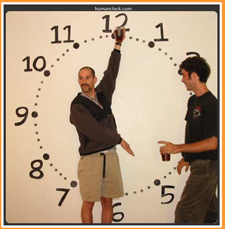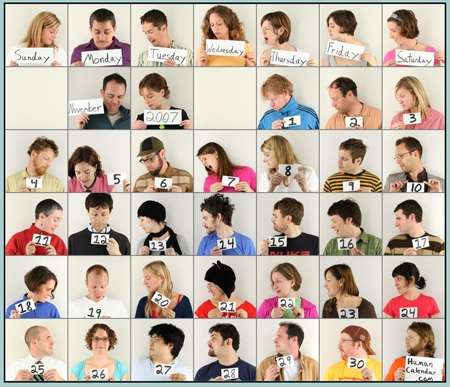
The Human Clock isn’t new. In some form, it has been around since 2001 as an effort to photograph a depiction of every minute of the day, changing images every 60 seconds. This summer, human clock creator Craig Giffen launched a sequel, the human calendar. The project—featured today in information aesthetics, a great blog on visualization—was some four years in the making.
The Human Calendar involves 40 of Craig’s friends roped into a photo shoot in his garage, capturing a total of 3,992 pictures. Each face is recorded next to a number or label helping comprise the calendar. The gaze of every person will follow the current date. The site also offers some widgets to bring this unique presentation to web pages everywhere.


Tell time with human analog and digital clocks
The Human Clock is a collection of individual photographs containing the current time information. There are multiple photos for each minute, rotating the images in some random fashion. The analog version merely represents all 1440 minutes in the day, but the digital clock consists of 15,356 photos. Fans of the clock have expanded on the initial set of photos to include images that include appropriate numbers captured in the wild. Some times have acquired additional cultural interest, and the clock photos even became a communication channel.
At the risk of re-inventing the same wheel, this approach to time might be useful in community building. Particularly in a university setting, where students and faculty come and go, a personalized version of the Human Clock and Human Calendar on display in building lobbies or on desktop monitors as screen savers might go a long way to improving recognizability and connection in a small program. I can imagine a photo shoot conducted as part of the incoming student orientation week at the IU School of Informatics, substituting the departing faces with new ones.
The Human Clock project has some social network cache, with a presence on MySpace. Craig—who has a fine appreciation of quality archival computers—has covered his bases with the domain name, too, having registered a similar but distinctive URL in case of a typo.
See also: the other human clock.

Human faces gaze at the current date in the human calendar